Value Perspective Quarterly Letter – Q4 2022 – UK
Our quarterly note covering the UK market

Authors
Looking into our crystal ball
For fund managers, Christmas is a time for reflection. Meeting and market volumes decline, providing a rare opportunity to breathe and think deeply about whatever you may care to think about. Many peer into crystal balls, attempting to predict the path for global markets and economies over the coming year. Regular readers, however, will know this is not our game. A significant amount of academic evidence (and over 22 years of personal experience) suggests that not only are economies extremely difficult to forecast, but even if you can accurately forecast them, it generally doesn’t help with forecasting what happens within markets.
The UK stock market in 2022 provides the latest (in a very long list) of examples. If in December 2021 we accurately predicted the most aggressive US rate increases in 40 years, a war in Europe, an energy crisis, cost of living crisis, a political crisis, a recession, rolling strikes across multiple industries, and systemic risk to the financial system from over-levered LDI funds, what would you have forecast the performance of the UK stock market to be during 2022? A forecast for it to increase, and to materially outperform overseas markets, would be laughable. But that is exactly what has happened.
That gives us comfort that using our precious reflection time to forecast economies would be time wasted. Instead, it is better to look for valuation extremes, which are a reflection of investor’s confidence one way or another, and simply ask “might that confidence be misplaced?”. Might things that currently look bleak improve? Might things that currently look fantastic deteriorate slightly? History suggests that few things stay the same, and as investors, being positioned ahead of any change can be extremely profitable.
At this point last year, we wrote the areas of the UK where investors were most pessimistic were Oil and Gas, Mining and Banking shares. During 2022 each of those sectors had a good year, although for reasons none of us would have been able to predict. We simply based our view on which sectors were most out of favour, which were cheapest, and therefore set to benefit the most if there was any alleviation of the negative headwinds those stocks had been facing. Last year, that worked out pretty well.
Today, the most vexing issue for investors is the forthcoming consumer recession. It is rare for economists to forecast recessions; famously the Bank of England has never forecast a recession – until now. The US faces a similar situation, with forecasters usually unable to forecast recessions (marked in grey on the chart below). Today, they are as sure as they’ve ever been, that a recession is coming.
The most anticipated recession ever

Source: Federal Reserve Bank of Philadelphia, Haver Analytics, Apollo Chief Economist
Around half of all UK owner occupied houses (4m) will be exposed to higher mortgage rates next year (either floating rate, or fixed rates expiring). Alongside an increase in energy prices from £2,500 to £3,000 for the average household in April ‘23, there will inevitably a squeeze on consumers. That much we know. What we don’t know, is what we don’t know. Surprising things may happen to make things better. Surprising things may happen to make things worse. Those ‘unknown unknowns’ are what make forecasting difficult.
Stock markets, of course, are forward looking. Share prices don’t wait for recessions to be announced before going down, nor wait for positive GDP figures to be announced before going up. The stock market has been particularly ruthless this year in marking down the share prices of consumer related stocks in anticipation of tough times ahead. The chart below shows the performance of every member of the FTSE 350, with the bars either green for non-consumer, and blue for consumer related stocks. A cursory glance will demonstrate the negativity surrounding the consumer, with the majority of consumer stocks very firmly on the left hand side of the chart.
Performance of FTSE 350 ex Investment trust by constituent from 31st December 2021 to 31 December 2022.
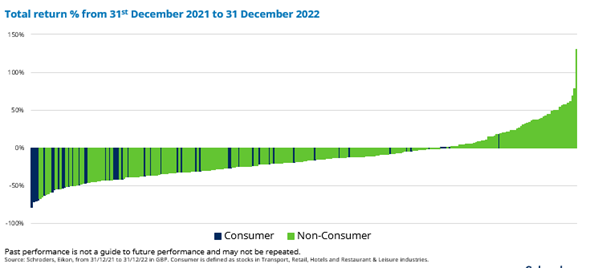
Source: Schroders, Eikon, from 31/12/21 to 31/12/22 in GBP.
If we wanted to put numbers on it, the average consumer stock has declined by almost exactly one third. Given that only a small proportion of a company’s value is driven by the cash generated in the next year or two, a -33% decline suggests the market has taken an extremely negative view of consumer stocks, not just for next year, but for the foreseeable future. Time will tell if that is overly aggressive. For reference, the average non-consumer stock is only down -9%.
“Hang on a minute” I hear you ask. The UK market is up during 2022, how can the average stock be down? The performance of the UK market is not based on the performance of the average company. Instead, the influence of each company on the benchmark is based on how large that company is. To take an extreme example, imagine a benchmark of 10 companies, with 9 of them having a market cap of £100m and one with a market cap of £1bn. As long as the large company doubled, the benchmark would be up slightly (by 5%) even if the other 9 companies went bankrupt, as the gains in the large company offset the losses in the small. In that situation, most investors will have lost significant amounts of money despite the market being up.
To a lesser degree, this is what happened within the UK market in 2022. The share price of a handful of very large companies increased, whilst the majority of companies fell. For those of you that like data, whilst the UK market was up during the year, three quarters of FTSE 350 UK companies had a share price which declined. That skew made it a very difficult benchmark to outperform, and indeed only 15% of active fund managers managed to do so within the IA UK All Companies in 2022.
But it was actually even more skewed than the analysis above suggests. If we take into account companies size, the narrowness of the market is even more extreme than when the S&P was dominated by a collection of stocks called the FAANGs (Facebook, Apple, Amazon, Netflix and Google) in 2021. During 2022, five stocks drove the entire UK market’s performance. If you had missed out on a collection of stocks we have nicknamed the BRAGS (BP, Rio Tinto, Anglo American, Glencore, Shell) the UK market return moved from positive to negative.
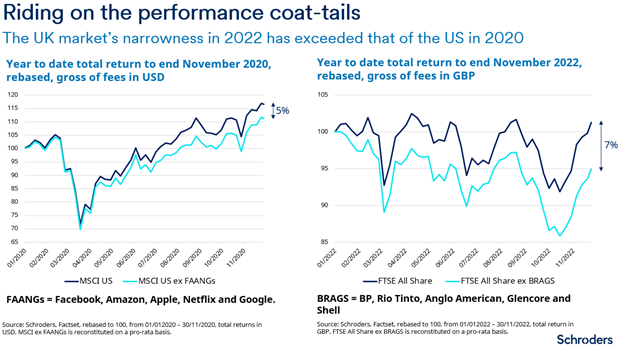
The corollary is whilst the UK market as a whole performed well in 2022, a majority of stocks fell. Indeed, if we cut the market into it’s size buckets, we can see that UK exceptionalism was driven by the large companies; the mid and small cap areas of the UK were even weaker than overseas markets.
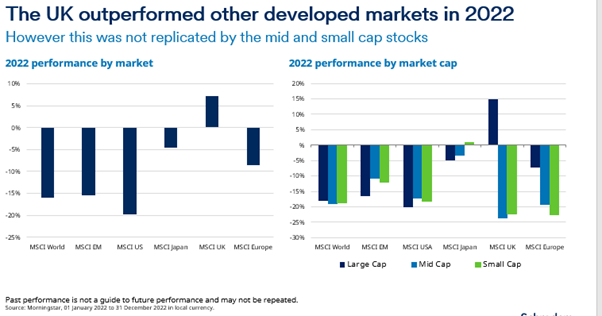
So far, this outlook statement has mainly focussed on what has happened during the past year. We do so deliberately as to know where we are going, it is helpful to first know where we are starting from. To recap: our forecasts last year were reasonably accurate by simply focussing on the cheapest areas of the market. The consumer is extremely likely to have a tough time in 2023, but consumer exposed share prices have declined significantly in advance. Finally, whilst a handful of stocks were up last year, the majority of stocks in the UK have declined leaving their valuations more attractive than they were at the start of the year.
As we did last year, let’s turn to sector valuations first to look for opportunity.
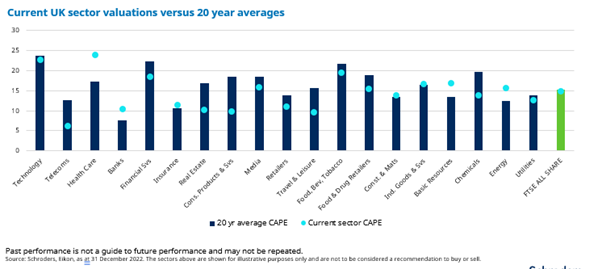
Source: Schroders, Eikon, as at 31 December 2022.
When we compare current valuations with their 20 year averages, we can see the areas that investors have most/least confidence in.
There are four sectors (Healthcare, Banks, Basic resources and Energy) more expensive than their 20 year averages. In every case, there is an articulate and persuasive reason for that valuation premium; that doesn’t make the reason true.
On the flipside, there are six sectors trading at significant discounts to their 20 year averages (Telecoms, Real Estate, Consumer Products & Services, Travel & Leisure, Food Retailers and Chemicals). Each of these sectors have headwinds today; but that doesn’t make the headwinds permanent.
To ensure our portfolios do not have style drift, and to ensure they represent the best opportunities today, we have been taking money out of the oil and gas and mining companies. These are areas which have done very well over the past year. We are rotating the proceeds into the areas most out of favour, where people are most pessimistic, and where valuations are lowest, buying real estate and retailing companies in particular. We are not doing so oblivious to the likely difficulties head, instead choosing to only buy the ones where balance sheets are strong and which can be sustained through a cost of living crisis. With the valuations these companies trade on, and the upside we see in a normal economic environment, they are likely to be the foundations of our portfolios performance over the next three to five years.
A few comments on risk are worth making at this point. Economists are not the only ones who struggle to forecast economies. When times are good, companies themselves cannot foresee changes, and often take on debt to expand, to pay large dividends, or to acquire competitors. When economic turbulence inevitably arrives, companies often find themselves overleveraged, with balance sheets ill-suited to the new economic reality.
This time is different. Whilst headlines are worrisome, companies have had time to prepare. All remember the lessons from the Covid downturn, indeed some are still flush with liquidity raised during the Covid months and rebound. The Bank of England, never ones for hyperbole and excitement, simply state “UK businesses are entering the period of stress in a broadly resilient position”.
That is not a unanimous position of strength, and as investors we need to be careful. Within the aggregate, there are a number of businesses where balance sheets are stretched, or where liquidity is low. Debt markets are less forgiving than they have been in recent years, and indeed have been closed to high yield issuance for much of the past year. This speaks to the importance of being extremely cautious when it comes to financial risk as some businesses will struggle to refinance maturing debt facilities.
Inevitably, that will result in some businesses turning to equity markets to plug their funding gap. Few portfolios have the remit to proactively seek these businesses out. Our Recovery funds are almost unique within the industry as having a sophisticated client base who understand the returns that can be generated from these situations. Whilst we are extremely unlikely to participate in all equity issuances, as one of the few industry participants with the specialist skills to evaluate rescue rights issues, we strive for a seat at the negotiation table with each of them. This can be time consuming, but for those companies where a fresh equity injection is part of a holistic refinancing package which removes the financial risk from the company, these opportunities can be extremely profitable for our clients.
Many outlook statements will reference the almost inevitably difficult times ahead – as we have above. However, I’d like to finish on two bits of good news. The first is that that valuation spreads remain elevated. Although not as wide as they were coming into 2022, the gap remains sufficient to provide a strong tail wind for valuation based investors over the coming years. We need to recognise that the tailwind may not blow in 2023 itself, but over the next three to five years, the outlook for valuation based investors from a relative perspective is a strong one.
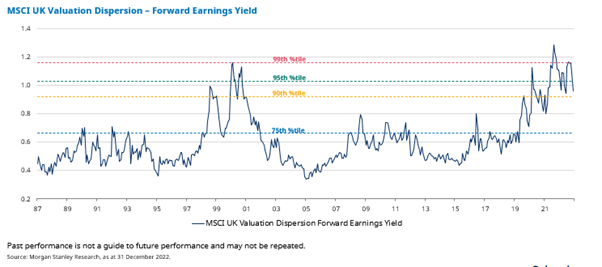
Source: Morgan Stanley, as at 31 December 2022.
The second thing to focus on is the remarkable opportunities there are for long term patient investors. For those of us willing (or able) to take a three to five year investment horizon there are significant numbers of stocks which screen as attractive, in diverse sectors, across the UK market. This offers the opportunity (but not guarantee) for strong absolute returns in the coming years. 2022 was the first year since 1996 that the UK was the strongest performing developed equity market. Perhaps it won’t be another 26 years until the next time.
Subscribe to our Insights
Visit our preference centre, where you can choose which Schroders Insights you would like to receive.
Authors
Topics